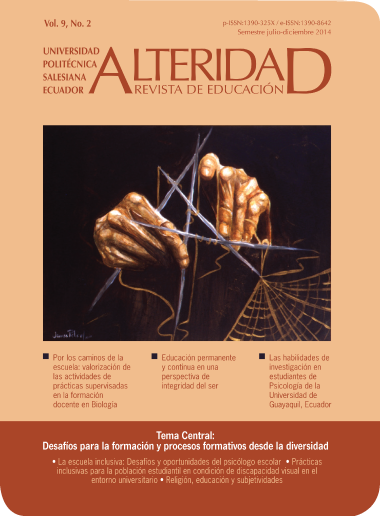Inclusive practices for the student with a visual impairment condition in the university environment
Main Article Content
Abstract
This article discusses the challenges facing higher education in providing the visual disabilities students best educational opportunities in equity condition, allowing them to be active, dynamic and responsible in theirs university education project. It is propose in a particular way the student`s needs in the university environment, focused on three levels: information-communication, mobility and educational process. This is presented from the visually impaired student´s point of view and experience, found in the research: Accessibility in the Permanence of Students with Special Educational Needs Associated or not to a Disability: Rodrigo Facio Headquarters (Gross and Stiller, 2012-2014). Also, it is presented a series of inclusive practices that have been applied for more than a decade at the University of Costa Rica, in order to provide some guidelines and strategies that support the educational process of the student with a visual impairment condition, in the university environment, from a unique, specific and inclusive perspective.
Article Details
Issue
Section
Central Theme
Authorship: The list of authors signing must include only those people who have contributed intellectually to the development of the work. Collaboration in the collection of data is not, by itself, a sufficient criterion of authorship. "Alteridad" declines any responsibility for possible conflicts arising from the authorship of the works that are published.
Copyright: The Salesian Polytechnic University preserves the copyrights of the published articles, and favors and allows their reuse under the Creative Commons Attribution-NonCommercial-ShareAlike 3.0 Ecuador license. They may be copied, used, disseminated, transmitted and publicly displayed, provided that: i) the authorship and the original source of their publication (journal, editorial and work URL) are cited; (Ii) are not used for commercial purposes; Iii) mention the existence and specifications of this license.
Copyright: The Salesian Polytechnic University preserves the copyrights of the published articles, and favors and allows their reuse under the Creative Commons Attribution-NonCommercial-ShareAlike 3.0 Ecuador license. They may be copied, used, disseminated, transmitted and publicly displayed, provided that: i) the authorship and the original source of their publication (journal, editorial and work URL) are cited; (Ii) are not used for commercial purposes; Iii) mention the existence and specifications of this license.
References
Asamblea Legislativa de Costa Rica (1996). Ley 7600: Ley de Igualdad de Oportunidades para las Personas con Discapacidad. San José: Diario Oficial la Gaceta.
__________(2008). Ley 8661: Convención sobre los Derechos de las Personas con Discapacidad y su protocolo facultativo. San José, Costa Rica: Litografía e Imprenta LIL.
Echeverría, A., Gross, M. y Stupp, R. (2008). Estrategias para la accesibilidad. SIEDIN-Universidad de Costa Rica.
Gallegos, M. (2011). La inclusión educativa en la Universidad Politécnica Salesiana. Alteridad, Revista de Educación, 6(2), 118-126. Quito: Universidad Politécnica Salesiana.
Gross, M. y Stiller, L. (2015). Contribución de la técnica del grupo focal al acercamiento a la percepción estudiantil sobre accesibilidad en el entorno universitario. Revista Actualidades Investigativas en Educación, 15(1). Universidad de Costa Rica: Instituto de Investigación en Educación.
Holst, B. (2006). Estudio bibliográfico: Ayudas técnicas, tecnologías de apoyo y accesibilidad. Heredia, Costa Rica: Centro de Investigación y Docencia en Educación, CIDE, División de Básica. Universidad Nacional.
Jiménez, R. (2002). Las personas con discapacidad en la Educación Superior. San José, Costa Rica.
Ministerio de Educación de Chille (2007). Guía de Apoyo Técnico Pedagógico de Necesidades Educativas Especiales asociadas a Discapacidad Visual.
Organización de Estados Americanos (1999). Convención Interamericana para la Eliminación de Todas las Formas de Discriminación contra las Personas con Discapacidad. Recuperado de: http://www. oas.org/juridico/spanish/tratados/a-65. html
UNESCO (1994). Declaración de Salamanca y marco de acción para las necesidades educativas especiales. Recuperado de: http://www. unesco.org/education/pdf/SALAMA_S.PDF
_________(2004). Index de Inclusión. Recuperado de: http://www.inclusioneducativa.org/mpysi. php?id=1
__________(2008). Ley 8661: Convención sobre los Derechos de las Personas con Discapacidad y su protocolo facultativo. San José, Costa Rica: Litografía e Imprenta LIL.
Echeverría, A., Gross, M. y Stupp, R. (2008). Estrategias para la accesibilidad. SIEDIN-Universidad de Costa Rica.
Gallegos, M. (2011). La inclusión educativa en la Universidad Politécnica Salesiana. Alteridad, Revista de Educación, 6(2), 118-126. Quito: Universidad Politécnica Salesiana.
Gross, M. y Stiller, L. (2015). Contribución de la técnica del grupo focal al acercamiento a la percepción estudiantil sobre accesibilidad en el entorno universitario. Revista Actualidades Investigativas en Educación, 15(1). Universidad de Costa Rica: Instituto de Investigación en Educación.
Holst, B. (2006). Estudio bibliográfico: Ayudas técnicas, tecnologías de apoyo y accesibilidad. Heredia, Costa Rica: Centro de Investigación y Docencia en Educación, CIDE, División de Básica. Universidad Nacional.
Jiménez, R. (2002). Las personas con discapacidad en la Educación Superior. San José, Costa Rica.
Ministerio de Educación de Chille (2007). Guía de Apoyo Técnico Pedagógico de Necesidades Educativas Especiales asociadas a Discapacidad Visual.
Organización de Estados Americanos (1999). Convención Interamericana para la Eliminación de Todas las Formas de Discriminación contra las Personas con Discapacidad. Recuperado de: http://www. oas.org/juridico/spanish/tratados/a-65. html
UNESCO (1994). Declaración de Salamanca y marco de acción para las necesidades educativas especiales. Recuperado de: http://www. unesco.org/education/pdf/SALAMA_S.PDF
_________(2004). Index de Inclusión. Recuperado de: http://www.inclusioneducativa.org/mpysi. php?id=1

